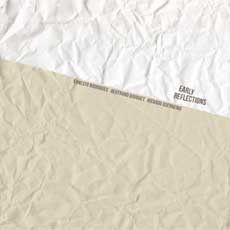
Ernesto Rodrigues - harp
Bertrand Gauguet- alto saxophone
Ricardo Guerreiro- computer
cs258
In artistic fields, contributions or innovations that impress the public at first seem increasingly anecdotal as time passes (examples include the exploration of non-narrative subjects by painting, the advent of orchestral percussion and even the Well-Tempered Clavier, all of which are now viewed by a large portion of the public as little more than ho-hum). Late 20th-century, improvised music was marked by a refinement and drastic reduction of the parameters it was then exploring as its musicians focused increasingly on timbre and space rather than interaction and energy, rhythm or phrase. Today, this new direction and the new territory it explored continue to surprise us.
Ernesto Rodrigues, Ricardo Guerreiro and Bertrand Gauguet are an integral part of that new generation of improvisers marked by Onkyo, the Wandelweiser collective, John Cage, Reductionism and Sound Art (overall, without including individual elements of Free Jazz, Free Improvisation, Noise and Electronic Music). Over the years, their music has become increasingly reduced, undergoing a process of refinement leading to the most radical tranquility and the most extreme minimalism (especially in the case of the two Portuguese musicians—the saxophonist has experienced a parallel evolution in other areas of electronic music). These elements emerge in the musicians’ relationship to their instruments, which approaches a passivity similar to that of Noise musicians. Rodrigues and Gauguet let themselves be guided by their instruments (and by space). And when one wants to leave room for silence, playing in an egalitarian manner and never fully filling the space, then, instrumental possibilities become extremely reduced. That is why this refinement can sometimes make their instrumental interventions seem rather poor. In fact, they are no less virtuoso and precise. It is only a matter of becoming accustomed to the presence of discrete sine waves, the importance of silence, the integration of music into the surrounding sonic environment, the equivalence of the latter two elements and that of instruments and computer, or notes and noises.
That explains this world of sustained sounds, absent forms, breath, caressed strings, noises and silence. At first listen, this music may seem simple or easy, but such is not the case. Rodrigues, Guerreiro and Gauguet are all gifted with a reserve that is perfect and ideal for the free deployment of sound, but they also possess an impressive precision and virtuosity (in how they attack and sustain their notes and sounds). One listen to Stone, recorded live, is enough to reveal this music’s magnificent integration into the sonic environment and space where it was performed, as well as the superb balance of noises, musical interventions and their respective reverberations. Everything is at the same level, nothing prevails, and generating that sort of equilibrium is not something just anyone can accomplish.
Apparently, Rodrigues, Gauguet and Gueirrero no longer need to explore timbres, sound textures or extended techniques. Now, this Franco-Portuguese trio is exploring space (through sound) and the relation of intentional instrumental sounds with those of the environment, not to mention silence. This interest, which they share with numerous contemporary musicians whose methods and horizons are different than theirs, may seem minimal, but it has yet to exhaust the available possibilities. The latter may be restricted, but they constitute a context in which these musicians manage to create, construct and explore sonic and musical territories that are always new.
Julien Héraud, January 2014
Translation by Wade Matthews